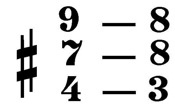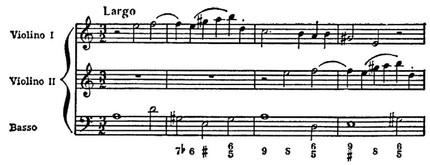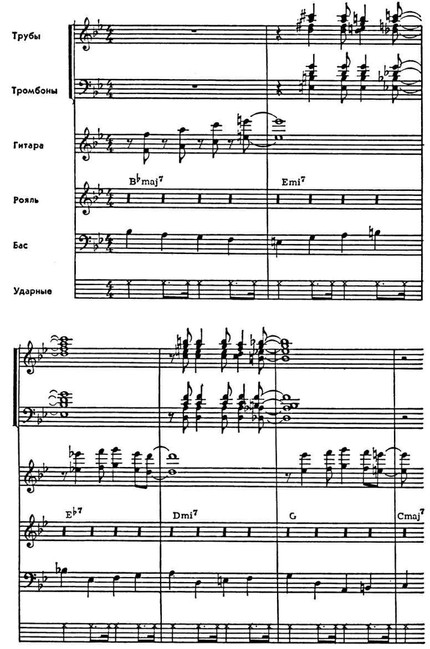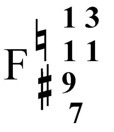
General-in-Chief
German Generalbas, Italian. basso generale, lit. – overall bass
Bass voice with numbers indicating consonances in the upper voices. Dr. names: Italian basso continuo thorough-bass, through-bass – continuous bass. Naz. also digital bass (Italian basso numerato, French basse chiffrée, German bezifferter BaYa). More rare old names are Italian. basso seguente, basso per l’organo, basso prinzipale, partitura d’organo. With the term “G.-b.” the practice of recording accompaniment to melodic is connected. voices in the form of G.-b., and also perform. practice playing digital bass on the organ and harpsichord. G.’s time of distribution – would be. (1600-1750) is often called the “epoch of H.-B.” G.’s samples. are found in C. Monteverdi, G. Schutz, A. Corelli, A. Scarlatti, J. S. Bach, G. F. Handel, J. Pergolesi, J. Haydn and others.
Name G.-b. the old teachings on the construction and connection of chords were also worn (they partially coincided with the early teachings on harmony; hence their once common identification).
G.-b. as a way of abbreviated recording of polyphony arose in Italy at the end of the 16th century. in the practice of organ and harpsichord accompaniment. Origin and the beginning of distribution G.-b. associated with the rapid growth of homophony in Europe. music at the turn of the 16th-17th centuries, with a prominent role in it of improvisation and ornamentation. Until the 17th century polygonal polyphonic compositions were copied and printed not in the form of a score, but only in the form of parts of the department. performing voices (polyphonic composers even hid the scores of their compositions in order to keep the secrets of their contrapuntal technique secret). To overcome the inconvenience arising from this when learning and performing complex products, ital. bandmasters and organists as early as the 16th century. began to use the abbreviated notation of the essay. The essence of the new technique was that at each moment of sounding the lowest sound of the accompanying voices (bass) was recorded, and the remaining sounds of these voices were recorded in numbers denoting the interval from the bass. That. a new, homophonic writing technique arose: a continuous bass (in contrast to the polyphonic lower voice interrupted by pauses) with chords above it. The same technique was used in the arrangement of polygons. compositions for the lute or for one solo voice with lute accompaniment (the practice of singing one of the voices of a polyphonic composition and performing the remaining voices on instruments has been used for a long time). In the beginning. 17th century the opera conductor (who was often also a composer) prepared the performance, writing out on the basis of G.-b. the required number of votes based on the performing staff at his disposal. Performance of accompaniment according to G.-b. on the organ and harpsichord included elements of improvisation based on this harmony.
Earlier just G.-b. was used in the “Church Concerts” (“Concerti ecclesiastici”) by A. Banchieri (1595) and “The Representation of Soul and Body” (“La rappresentazione di Anima e di Corpo”) by E. Cavalieri (Spanish 1600). Consistent application of G. – would be. finds in L. Viadana’s “100 Church Concerts” (“Cento concerti ecclesiastici…”) (1602), which for a long time was considered the inventor of H.-b. In the preface to this work, Viadana speaks of the reasons that prompted him to use G.-b.; the rules of digitization and execution according to G.-b. are also explained there. Such indications are also contained in the works of A. Bankieri (“L’ organo suonarino”, 1607), A. Agazzari (“Sacrae cantiones”, 1608), M. Pretorius (“Syntagma musicum”, III, 1619; Faksimile-Nachdruck, Kassel -Basel-L.-NY, 1958).
As a method of composition G.-b. is a vivid expression of homophonic harmonic. letters, but as a notation system bears the imprint of polyphonic. the concept of vertical – understanding the chord as a complex of intervals. Ways of notating chords: the absence of numbers (and other indications) means diatonic. triad; all harmonies are subject to digitization, except diatonic. triads; number 6 – sixth chord,

– quarter-sextakcord; numbers

– diatonic. seventh chord and its appeals; 9 – non-chord. Thirds are usually not marked; an accidental sign (sharp, becar, flat) without a number refers to a third; the accidental sign next to the number means chromatic. modification of the upper sound of the corresponding interval (from the bass). Chromatic an increase is also indicated by crossing out a number or a + sign after it – an increase in a sixth, 4+ – an increase in a fourth). Non-chord sounds are also indicated by numbers from the bass (4 – a triad with a downward delay to a third,

– triple detention of a quart, a seventh and a nona with his resolution). The indications tasto solo (“one key”, abbr. ts) prescribe the performance of one bass, without chords. In the beginning. 17th century G.’s practice – b. quickly spread to Europe. countries. All organists and bandmasters were required to master the skills of playing and improvising according to G.-b. Introduction G.-b. originally had a positive meaning. Under the predominance of the simplest chords and strict treatment of dissonances, G.-b. facilitated the learning and execution of complex compositions.

J. S. Bach. Sonata for 2 Violins and Digitized Bass, movement III. Original.

The same, deciphered by L. Landshoff.
In practice of G.’s application – would be. arose and strengthened terminology. designations of the main, most frequently occurring chords – a sixth chord, a quarter-sextakchord, a seventh chord (hence the custom to omit the triad notation that was used too often: In that era, however, this did not have significant significance. As harmonic techniques proper developed and refined, more and more new digital designations (signatures) were introduced into everyday life. Thus, in the early manual of I. D. only 1711 signatures, in his later work (12) there are already 1728 of them, and I. Mattheson (32) brings their number to 1735.
As the doctrine of harmony developed, more precise ways of designating chords were found. Muses. practice to ser. 18th century abandoned the approximate transfer to the accompaniment of the author’s intention and minimized the role of performing improvisation. G.-b. ceased to be used, although for a long time he was kept in pedagogical. practice as an academic discipline that instills the skills of performing baroque music, and as an exercise in harmony. Guides to G. – b. were composed by F. E. Bach (1752), F. V. Marpurg (1755), I. F. Kirnberger (1781), D. G. Türk (1791), A. E. Koron (1801), F. Zh. Fetis (1824), Z. Dehn (1840), E. Richter (1860), S. Jadasson (1883), X. Riemann (1889) and others. In Russian. language translated “A Brief Guide to the Study of G.-B.” O. Kolbe (1864).
In present At the same time, the remnants of the doctrine of G.-B., absorbed by the doctrine of harmony, are found in the methods of digitizing chords used in most textbooks. A kind of partial revival of the practice of G.-b. is observed in jazz and light estra close to it. music. The prerequisites for this are the improvisation of the performance, the association of the accompanying group (guitar, piano) with percussion instruments, the standard texture of the accompaniment. Often the recording of a song is a presentation of a melody, harmonica. bass with digital and basic. counterpoints; the texture of middle voices is written out in a simplified way, the arranger and the performer are given the opportunity to vary it at their discretion. The chords are notated differently.

K. Velebny. From the book Jazz Practice.
The most common way of notation is to designate main. chord tones (C – sound C, C  — sis, E
— sis, E  – es, etc.), type of triad (G – triad G-dur, Gm – g-moll, G + – increased triad), in the digital designation of sounds added to the triad (
– es, etc.), type of triad (G – triad G-dur, Gm – g-moll, G + – increased triad), in the digital designation of sounds added to the triad (

– c-es-gad chord,

– fac-es-gis-hd, etc.); mind. seventh chord – E  dim, etc. Chords in the piano part. notated in one of the digitization options: B
dim, etc. Chords in the piano part. notated in one of the digitization options: B  maj7 (major seventh chord) – bdfa chord, Emi7 (min. seventh chord) – eghd, E
maj7 (major seventh chord) – bdfa chord, Emi7 (min. seventh chord) – eghd, E  7 – es-gb-des, G+ – gh-es (cf. digits with trombone chords). This designation reveals the essence of G.-b.; it does not convey that the gh-es chord should be notated as an inversion of uv. triads from es, a not SW. triad from g. G.-b. was and still is helpful. means for the performer, “music. shorthand” rather than scientific theory.
7 – es-gb-des, G+ – gh-es (cf. digits with trombone chords). This designation reveals the essence of G.-b.; it does not convey that the gh-es chord should be notated as an inversion of uv. triads from es, a not SW. triad from g. G.-b. was and still is helpful. means for the performer, “music. shorthand” rather than scientific theory.
References: Kelner D., True instruction in the composition of the bass general …, M., 1791; Czerny K., Letters … or Guide to the study of playing the piano …, St. Petersburg, 1842; Ivanov-Boretsky M., Musical and historical reader vol. 1-3, M., 1928, revised. ed., no. 1-2, M., 1933-1936.
Yu. N. Kholopov



